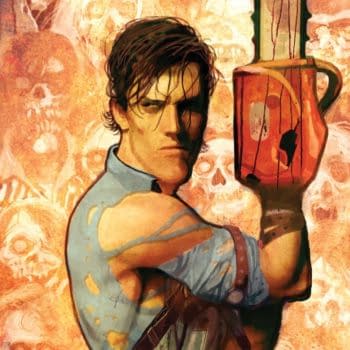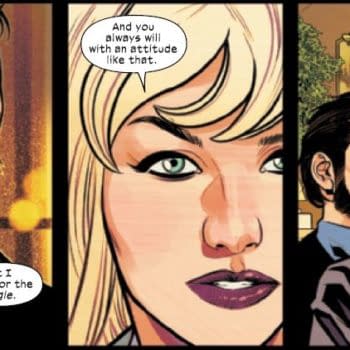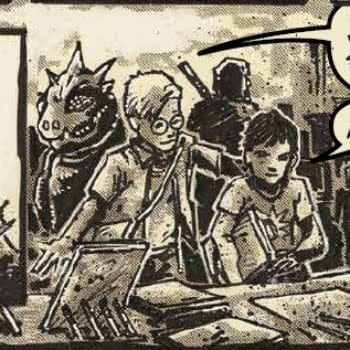Posted in: Comics | Tagged: Alan Moore, ben templesmith, black mask, dean haspiel, douglas rushkoff, J.M. DeMatteis, Joshua Dysart, Joshua Hale Fialkov, mike cavallaro, occupy comics
Aim Your Ire Up: Occupy Comics #1 Review
It's important to look beyond the obvious when we're reading the books we love or watching the shows we adore. It's not our fault that we get excited and miss the forest for the trees. Or maybe just glade for the clearing? We're definitely missing something a lot of the time (sometimes). How's that for clarity? What's going on on the cover of Occupy Comics #1? There's a nude woman and she's standing on the world and she's poking at the moon. It's by someone called "ALL-RED" who, if you ask me, has a pretty good career in comics ahead of him (KNOWING WINK). But what does it mean? This is the cover to an Occupy comic, shouldn't it be a boot stamping on a human face forever? Or a bunch of kids with bandanas hurling molotovs into the windows of Madison Avenue Suitbags? (Suitbags is a new term I just came up with for douchebags who wear suits!) It's an image that gives off an immediate calming effect, the sun is glowing blur and her ghost like hair blows on impossible space winds, her face might be sad, it might be knowing, we can't really see. What is clear is that Occupy Comics did not come here to rough you up, scream in your face or beat you with slogans. They're here to reach out to you, to poke you like a giant naked space girl, tagging the moon "it". (I don't know what's going on, just because I brought it up doesn't mean that I'm privy to the inner workings of the artist mind. So I'm calling it an intergalactic game of tag.)
That pairing of unassuming beauty with surprising earnestness sets the tone for the book which picks up and sheds sequential art appearances like COINTELPRO agents at a Yippie gathering. Joshua Hale Fialkov, who most fans would probably associate with horror comics kicks off the book with a strip about a different kind of horror, the horror inflicted upon workers during the tumultuous birth of the labor movement in the United States during the late 19th century. The strip is laid out to look like it came from 100+ years ago, yellowed and frayed pages over intense and exhaustive linework from Joseph Infurnari that definitely and defiantly beats back against the "all digital all the time" feel of so many modern comics.
J.M. DeMatteis pairs with Mike Cavallaro for a personal and spiritual walk through the occupy movement. The tone is friendly and unassuming and the art simple yet expressive. Douglas Rushkoff & Dean Haspiel present a history of exploitation, delivering in one page a succinct and stirring trip through time. The reader is treated to the overlords of each epoch from Pharaoh to laptop, blurry workers and focused enforcers. Ben Templesmith's "Clever" shows that the scariest creations to come from Templesmith's dark art worlds might be the least fictional as his skeleton bankers move across a poisoned landscape. "Occupy Shadows" is a lighter note, a story from Ronald Wimberly about how the different sides of the class line react in a crisis.
One of the more hilariously depressing side effects to come out of the mass-brainwashed, mass media, wave of the future, unperceptive present has to be the way in which the professional cheaters and liars adapted the behavior of those they had been fucking. So while we suffer years of constant streams of lies coming from our leaders and the liars they employ, the second someone brings up a subject that counters their stance, they turn on the "Well lets see the proof" card. The very card they've built careers learning hours of spin and lies to avoid ever answering. Global warming? Let's see the proof! Oh but foreign enemy weapons? Trust us. Well Occupy gives you your proof and more thanks to the efforts of Joshua Dysart, Kelly Bruce, Allen Gladfelter, Alan Moore and Hannah Means-Shannon. The teams that are in charge of the "wordy bits" (as I like to call 'em) in the back of the book.
"Casino Nation" by Dysart, Bruce & Gladfelter dresses up the corporate criminals as playing cards, stark hard art for stark hard words. "Casino Nation" arms you with the information that you need to know, so when you get angry you know where to aim your ire. Aim your ire up where it belongs. While Alan Moore's essay (edited by: H.M.S.) "Buster Brown At The Barricades" presents an alternate history of comics than the ones I'm sure you're just as tired of reading as I am. When I first saw the hieroglyphic picture I thought, "Oh god not another essay about the history of comics that's just a bunch of boring pages about how Egypt and papyrus and blah blah blah". Then I actually started reading and was beyond delighted to discover that the essay was instead about how comics have always been a tool to undermine the status quo, giving the audience the context to fully appreciate and understand (and enjoy, natch) the pairing of Occupy and comics.
The final strip arrives by Matt Pizzolo and Ayhan Hayrula and it should immediately take the wind out of any reactionary blowhard that wants to paint Occupy like a group of shouty, thick delinquents, (they're actually quiet, thin, delinquents). "Channel 1%" pairs up (of all people) The Tea Party Movement with the Occupy Movement, to address how both movements were immediately co-opted by the national media and turned into the easiest to sell circus of hype and lies. The comic is so thoughtful and so fair that it immediately pissed me off. I hated feeling my righteous rage and indignation slip away and I hated having to resign myself to a more understanding and open hearted spiritual activism, but I'm happy I did.
There's plenty more in the book than what I covered here, there's work by Art Spiegelman, Matt Bors and David Lloyd. There's an energy to it, a life to it, it doesn't feel like you just bought a missive from a zealot or a manifesto from a mercenary. It feels real and it feels hopeful, it allows you to feel and it doesn't do your thinking for you. It's a comic unlike any other comic you'll find in the shop, for now…












